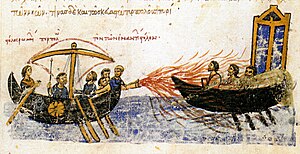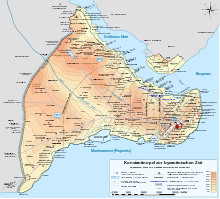Siege of Constantinople (717-718)
| date | August 15, 717 to August 15, 718 |
|---|---|
| place | Constantinople |
| output | Byzantine-Bulgarian victory |
| Parties to the conflict | |
|---|---|
| Commander | |
| Troop strength | |
| approx. 200,000 men, 1,800 ships | 30,000 Byzantines, 50,000 Bulgarians |
| losses | |
|
130,000 to 170,000 men, 1795 ships |
unknown |
Al-Hira - Jarmuk - Kadesia - Heliopolis - Nehawend - Constantinople I - Constantinople II - Talas
Byzantine-Arab Wars
Early battles
Mu'ta - Tabuk - Dathin - Firaz
Arab conquest of the Levant
Qartin - Bosra - Adschnadain - Marj al-Rahit - Fahl - Damascus - Marj ad Dibadsch - Emesa - Yarmouk - Jerusalem - Hazir - Aleppo
Muslim conquest of Egypt
Heliopolis - Alexandria - Nikiou
Umayyad conquest of North Africa
Sufetula - Vescera - Carthage
Umayyadidische invasion of Anatolia
and Constantinople
Iron bridge - Germanikeia - 1. Konstantin Opel - Sebastopolis - Tyana - 2. Konstantin Opel - Nicaea - Akroinon
Arabic-Byzantine border war
Kamacha - Kopidnadon - Krasos - Anzen and Amorion - Mauropotamos - Lalakaon - Bathys Ryax
Sicily and Southern Italy
1st Syracuse - 2nd Syracuse - Campaigns of the Maniac
Byzantine counter-attack
Marasch - Raban - Andrassos - Campaigns of Nikephoros Phokas - Campaigns of John Tzimiskes - Orontes - Campaigns of Basil II. - Azaz Sea
operations
Phoinix - Muslim Conquest of Crete - Thasos - Damiette - Thessalonike - Byzantine reconquest of Crete
The siege of Constantinople from 717 to 718 was the second heavy attack by the Arabs on the Byzantine capital. It ended with the successful assertion of the city by the Byzantines and Bulgarians, thereby temporarily putting a stop to Islamic expansion .
background
Despite the failed first siege of Constantinople (674–678) , the Islamic expansion in east and west continued almost unstoppably. The last Byzantine outpost in North Africa fell with Carthage in 698, and in 711 the Visigothic Empire was defeated in the battle of the Río Guadalete . In the east the Indus and Oxus were crossed. The Umayyad caliphate felt strong enough to attack the Byzantine capital again. Already Al-Walid I made the appropriate preparations, but died before realizing his plans. His younger brother and successor to the throne, Sulayman , continued the effort.
Meanwhile, Byzantium also registered that it had again come into the focus of the Arabs. A few years of confusion about the throne after the death of Justinian II prevented effective measures, only Anastasios II made preparations against an imminent siege from 713 onwards. The walls were reinforced, the navy upgraded, and the city's warehouses filled. Anastasios ordered the residents of Constantinople to either stock up on supplies for three years or to leave the city. His forward-looking steps proved correct, but he was overthrown in 715 after only two years in office. His successor was Theodosius III. , who also ruled for only two years until Leo III in March 717 . was elected emperor.
In the summer of 715, Caliph Sulayman gathered an army near Aleppo . Under the orders of his brother Maslama , it was to cross Asia Minor towards Constantinople. At the same time, a fleet of 1,800 ships under Sulaiman's command set out. In the winter of 716/17, however, she anchored off the Cilician coast while the army retreated to eastern Anatolia. In spring Maslama finally set out, conquered Pergamon and crossed the Dardanelles near Abydos . On August 15, the army reached the walls of Constantinople, set up a fortified camp, and waited for the fleet, which finally arrived on September 1 on the Bosphorus.
course
As of September 717, Constantinople was enclosed both by land and by sea. The Byzantine fleet was protected by an iron chain that Leo III. across the harbor entrance, in the Golden Horn . On September 3, the Muslim fleet advanced to trap the Byzantines in the ports of the Marmara Sea from the east and north. The rearguard of twenty heavy ships lost track, which Leo III. immediately took advantage of. Under his personal leadership, a squadron of galleys destroyed the enemy ships with Greek fire . Discouraged by this mishap and by a futile attempt to storm the sea walls with the help of boarding bridges, the fleet retreated north into the Bosphorus and anchored around today's Rumeli Hisarı . The land army under Maslama failed meanwhile due to the strength of the Theodosian wall . After numerous unsuccessful attacks, it was limited to a siege.
The winter of 717/18 began unexpectedly early and became unusually severe, with Thrace lying under a blanket of snow for over a hundred days . The supply situation for the attackers deteriorated dramatically. Camels and horses froze to death or were slaughtered and eaten, even soldiers fell victim to the cold. A supply fleet arrived from Egypt the next spring , including 400 heavy ships with additional siege equipment. In the wake of this fleet were also Christian sailors who overran the Byzantines in dinghies. Encouraged by their information about attack plans and the condition of the Muslim fleet, Leo opened the fight with his dromons . With the help of the Greek fire , the main fleet was directly attacked and destroyed. With the destruction of the Arab naval forces, the sea route to Constantinople was again open, while the Muslims were cut off from supplies by sea.
In the meantime, parts of Maslama's troops, who were plundering through Bithynia , were increasingly held in check by mobile Byzantine units, so that the supply routes via Asia Minor for Constantinople were again open. Finally, Leo even managed, surprisingly, to persuade the Bulgarians under Khan Terwel to attack from the north. Although the Bulgarians were traditional enemies of the Byzantines, they saw the Arabs as the greater threat. When 20,000 to 50,000 Arabs fell under the walls of the capital after the Bulgarian attack, the siege of Constantinople and the war were practically over. Finally, the Arabs finally withdrew from the Bosporus on August 15, 718, exactly one year after the siege began. Arab historians put the war losses on their side at 500,000 men, more likely losses of 130,000 to 170,000 men and almost all of the 1,800 ships.
episode
The defense of Constantinople was of great importance for the history of Europe. With the almost complete loss of their fleet, the naval domination of the Arabs in the eastern Mediterranean was initially broken. On the straits between the Black Sea and Aegean Sea , the advance of the Muslims, who at that time controlled over half of the Mediterranean coast, had been halted. Constantinople had once again shown itself to be an impregnable fortress, and this was to remain so until it was captured by the Crusaders during the Fourth Crusade . Nevertheless, the first mosque in Constantinople is said to have been built in 718 as part of the armistice agreements for Arab prisoners of war and traders .
See also
swell
- Theophanes . The chronicle of Theophanes Confessor. Byzantine and Near Eastern history AD 284-813 , Clarendon Press, Oxford 1997, ISBN 0-19-822568-7 .
literature
- Leslie Brubaker, John F. Haldon: Byzantium in the Iconoclast era. c. 680-850. A history. Cambridge University Press, Cambridge et al. 2011, ISBN 978-0-521-43093-7 .
- Ekkehard Eickhoff : Sea war and sea politics between Islam and the West. The Mediterranean under Byzantine and Arab hegemony (650–1040) . De Gruyter, Berlin 1966.
- Paul Speck: Emperor Leon III. The historical works of Nikephoros and Theophanes and the Liber Pontificalis. A source-critical investigation. Part 1. The beginnings of the government of Emperor Leon III . Bonn 2002 (= ΠOIKIΛA Byzantina 19), pp. 283–372.
- Ilse Rochow: Byzantium in the 8th century as seen by Theophanes. Critical historical commentary on the years 715–813 . Berlin 1991 (= Berlin Byzantine Works 57), pp. 86–97.
Remarks
- ↑ Peter Schreiner: Constantinople - History and Archeology. Munich 2007, p. 85.


